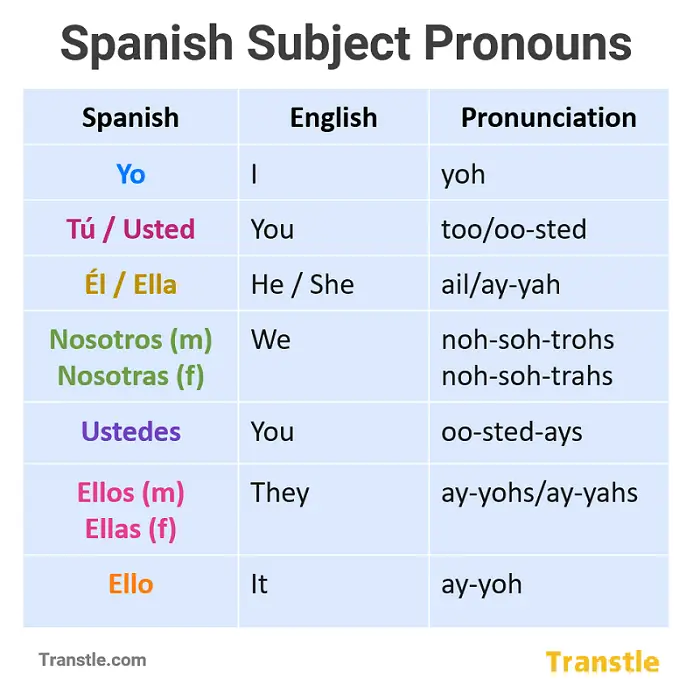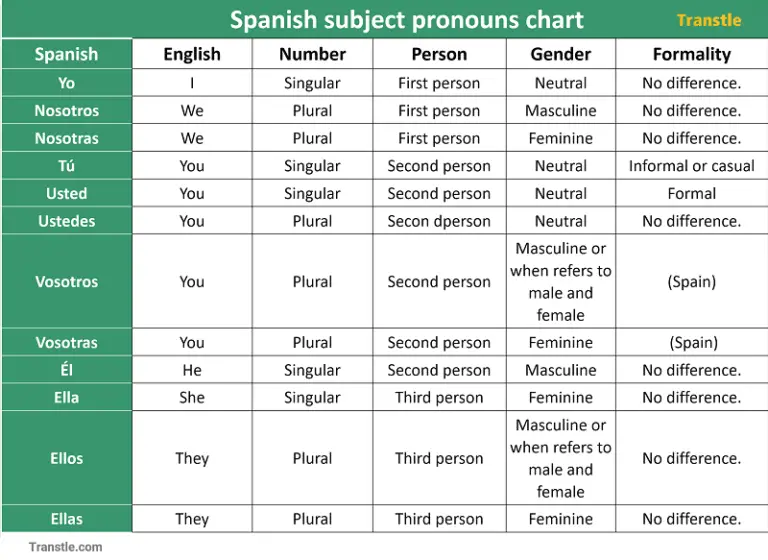Spanish Subject Pronouns: Guide, Chart, Examples & Exercise

Spanish Subject Pronouns
Spanish subject pronouns are words that are used to refer to the subjects of the sentence, they are the words I, you, he, she, we, you, they and in Spanish they are Yo, tu, él, ella, nosotros, ustedes, ellos and ellas. They are a type of pronoun and knowing them is necessary to be able to build from the most basic sentences to the most complex ones, therefore, it’s one of the first lessons you have to learn.
This is a complete and comprehensive guide where you will learn everything about spanish subject pronouns.
What is a pronoun in general sense
A pronoun is a word that replaces a noun, that means that it replaces a person, animal, or thing. They refer to them without having to name them directly and sometimes, to avoid their repetition. There are several types of pronouns but here we’re studying subject personal pronouns.
Example
|
Table of Contents
Chart of the Spanish Subject pronouns
Here are the most common Spanish subject pronouns. Note the pronunciation to help you speak with confidence.
| Spanish | English | Pronunciation |
|---|---|---|
| Yo | I | Yoh |
| Tú / Usted | You | too / oo-sted |
| Él / Ella | He / She | ail / ay-yah |
| Nosotros (m) / Nosotras (f) | We | noh-soh-trohs / noh-soh-trahs |
| Ustedes / Vosotros / Vosotras | You | oo-sted-ays / boh-soh-trohs / boh-soh-trahs |
| Ellos (m) / Ellas (f) | They | ay-yohs / ay-yahs |
| Ello | It (No tiene traducción literal directa al español) | — |
Notes: m is male and f female. Spanish has two words for “you” and “we.” We’ll explore this a bit more below!
Examples or sentences
|
Gender and number
The key to Spanish subject pronouns lies in understanding how gender and number affect the plural forms.
1. Singular Pronouns: No Gender Change
Yo, Tú/usted (singular), él and ella (I, you, he and she) are singular and their form does not change regardless of the subject’s gender.
Examples:
|
2. Plural Pronouns: Gender changes – Nosotros and ellos
The pronouns Nosotros, Ellos, (We, They) are plural and they do change depending on the gender of the subjects, these pronouns follow these rules:
Endings in os are male -os neutral and -as are female.
| Subject ponoun | English | Rule for Use |
| Nosotros | We (Masc./Neutral) | Use for groups of males only, or groups with both males and females. |
| Nosotras | We (Feminine) | Use only if the group is exclusively female. |
| Ellos | They (Masc./Neutral) | Use for groups of males only, or groups with both males and females. |
| Ellas | They (Feminine) | Use only if the group is exclusively female. |
Examples:
|
2. Plural “You”: Regional Differences (Ustedes vs. Vosotros)
The way to address a group of people depends heavily on the region.
In Latin America, you say “you” in plural just by using Ustedes and that already includes male and female.
In Spain, you can use Vosotros and Vosotras depending on the genders of the persons with whom you’re talking.
Ustedes (Latin America) | Neutral. Used for any group, regardless of gender. |
Vosotros, Vosotras (Spain) |
|
Examples
Vosotros estabais en Madrid (m – m/f) – You were in Madrid. Vosotras estabais en Madrid (f) – You were in Madrid. |
Tú vs. Usted vs. Vos
In Spanish, there are three main ways to say “you” in the singular. Your choice depends on the social norms of the region you are in and the level of formality required by the situation.
Determining Factors
- The kind of relationship you have with the person with whom you’re talking: Casual or formal.
- The age differences between the subjects.
- The regional variations: Latin American Spanish or Spanish from Spain.
Tú | If it’s a informal/casual relationship such as a friend, relative, or a young person. |
Usted | If it’s a formal/respecful relationship, like a boss, someone you don’t know, or someone a lot older. |
Vos | Informal/Regional. In Argentina, Uruguay, Paraguay and few regions of Colombia and Venezuela. |
Want to learn more? Dive deeper into the difference between formal and informal Spanish. 👉 Click here to learn more about Tú vs. Usted or about voseo
How to use the subject pronouns
- They usually go at the beginning of the sentence.
- Spanish subject pronouns are not capitalized unless they start a sentence.
- In English is mandatory to use it, while in Spanish it’s not.
Ella come ensalada – She eats salad. Come ensalada – You can not say eats salad, you need to say the pronoun, in this case, it’s she. |
Omission of the pronoun
A key difference from English is that Spanish often allows you to omit the subject pronoun. This is because the verb’s ending already tells you who the subject is. For example, instead of saying “Yo como pizza,” you can simply say “Como pizza” and people will know you mean “I eat pizza.”
Want to learn more about this rule? 👉 Click here for a full guide on omitting subject pronouns
When to use the subject pronouns
After Some Prepositions to Emphasize the Subject:
- ¿Y qué van a hacer ustedes? – What will you do?
- Ella sí que es talentosa. – She really is talented.
After the Verb “Ser” (To Be):
- Soy yo. – It’s me.
To Point Out Someone:
- ¿Quién quiere comer? Él. – Who wants to eat? Him.
For More Clarity or Contrast:
- Ellas estudiaron, pero ustedes no. – They studied, but you all didn’t.
To Compare:
- Él hace más ejercicio que tú. – He works out more than you do.
After Certain Prepositions:
- Según tú. – According to you.
Summary chart

Exercises
Here are some simple exercises to help you practice using Spanish subject pronouns.
Exercise 1: Fill in the Blank
Fill in the blank with the correct Spanish subject pronoun.
- ____ (I) quiero aprender español.
- ____ (He) es un buen vecino.
- ____ (We, mixed group) amamos la comida mexicana.
- ____ (They, feminine group) están enamoradas.
Exercise 2: Tú vs. Usted
Choose the correct pronoun (tú or usted) for each situation.
- Talking to your best friend: ____
- Talking to your new boss: ____
- Talking to a child: ____
- Talking to a stranger who is older than you: ____
Exercise 3: Translate
Translate the following English phrases into Spanish.
- You (informal) are very tall.
- She drinks coffee.
- They (masculine/mixed) are in love.
- We (all-female group) love Mexican food.
Answers
Exercise 1
- Yo
- Él
- Nosotros
- Ellas
Exercise 2
- Tú
- Usted
- Tú
- Usted
Exercise 3
- Tú eres muy alto.
- Ella toma café.
- Ellos están enamorados.
- Nosotras amamos la comida mexicana.

Time's up
Read next